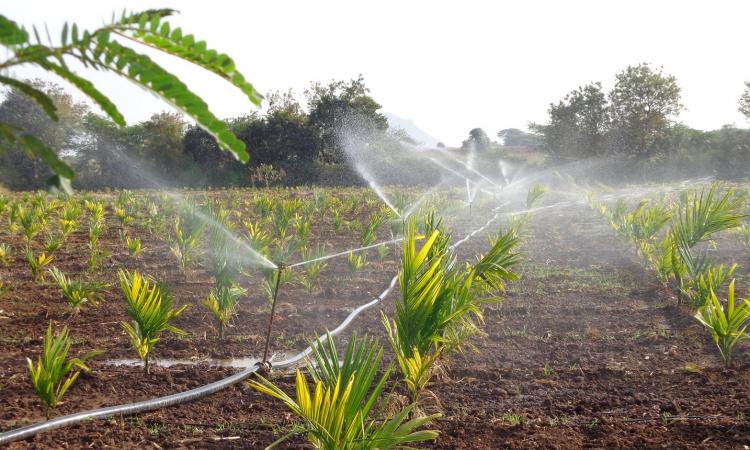
Karnataka is planning the world's biggest micro irrigation project by bringing 7 lakh hectares of land under drip and other systems, and along with Maharashtra, is making drip irrigation mandatory for sugarcane cultivation. This didn't happen by accident; rather the unsustainability of conventional irrigation practices has forced policy makers to pay greater attention to micro-irrigation practices, which primarily involve the use of sprinkler and drip irrigation. These systems supply water efficiently and reduce loss due to seepage, run off and evaporation. While a sprinkler would spray water uniformily over the field, drip irrigation systems supply water in drops to the root area of the plant.
There has been a constant rise in area under micro irrigation in India. However, despite their increasing popularity thanks to huge government subsidies, micro-irrigation techniques still serve only 5.71 per cent of the total irrigated area in the country.
Hover over the infographics for more detail
The micro irrigation systems’ ability to deliver water and nutrients directly to the plant minimises losses and increases the crop yield. This technique has reduced irrigation costs, electricity consumption and fertilizer usage while increasing irrigated area, crop yields and the farmer’s income.
Adopting micro irrigation has also brought about a change in cropping patterns, with farmers favouring less water-intensive but high value crops. Areas under soybean, cotton, paddy, wheat, maize etc. registered a decline while groundnut, mustard, banana, kinnow and guar have increased.
Despite its obvious advantages, micro irrigation techniques aren't being used extensively. The cost of system per hectare ranges from Rs 16,700 to Rs 57,600 depending upon the technology used, cropping pattern and spacing. Since Indian farmers are used to getting water at a low cost, they don't feel the need to switch to this technology, especially since subsidies are available only for those with a maximum of 5 hectares of land. This leaves out medium and bigger scale farmers who occupy over 55.42 percent of the total farm land in the country -- who also over-extract groundwater.
Technicalities associated with micro irrigation and poor post-installation service also put off many. An evaluation study of micro-irrigation schemes by the Planning Commission found that only 56 percent farmers were satisfied with after-sales service. Many did not attend orientation trainings to get better technical knowledge of the system.
These systems are better suited for horticulture crops and field crops that require less water in short frequencies. Even though experiments with paddy cultivation using drip irrigation shows promising results, it is yet to be tried on a large scale.
The need to adopt micro-irrigation can be understood by looking at the current irrigation scenario in the country. According to the Economic Survey 2014-15, 45 percent of the total cropped area in the country is currently irrigated. Groundwater, being decentralised and more in control of the farmers, serves most of this irrigated land (62 percent) while canals reach only 26 percent. The latter also has poor water-use efficiency of only 38 percent thanks to damages and siltation, leakages, non-provision of lining etc. This further promotes the use of groundwater leading to over-extraction and increased cost of redigging borewells.
In 2000, water available for agriculture was 83 percent which is estimated to decline to 70 percent by 2025 as the water needed for industry rises. Since crops take lesser water with micro irrigation, farmers are able to irrigate a larger area with the same source of water. Do we need more data to make the case to adopt micro irrigation?